MGT60035: Risk Management, Strategy, and Adaptation Report
VerifiedAdded on 2023/01/19
|13
|3594
|54
Report
AI Summary
This report delves into the intricate relationship between risk and strategy within project management, emphasizing how adaptation can enable organizations to achieve strategic objectives and overcome challenges. It begins by defining risk and strategy, highlighting their interconnectedness, and explores various perspectives on risk, including risks to, from, and of strategy. The report then examines how organizations can adapt to mitigate risks and seize opportunities. It outlines a process for adaptation that includes determining strategic positions, developing strategic plans, executing and managing plans, and reviewing and revising plans. Furthermore, it presents a detailed risk assessment process, including establishing context, identifying, and analyzing risks, and provides real-world examples to illustrate these concepts. The report emphasizes the importance of a balanced approach to risk management and strategic planning, highlighting how these two elements work together to create value and ensure organizational success. The report also includes references to support the claims and arguments presented.
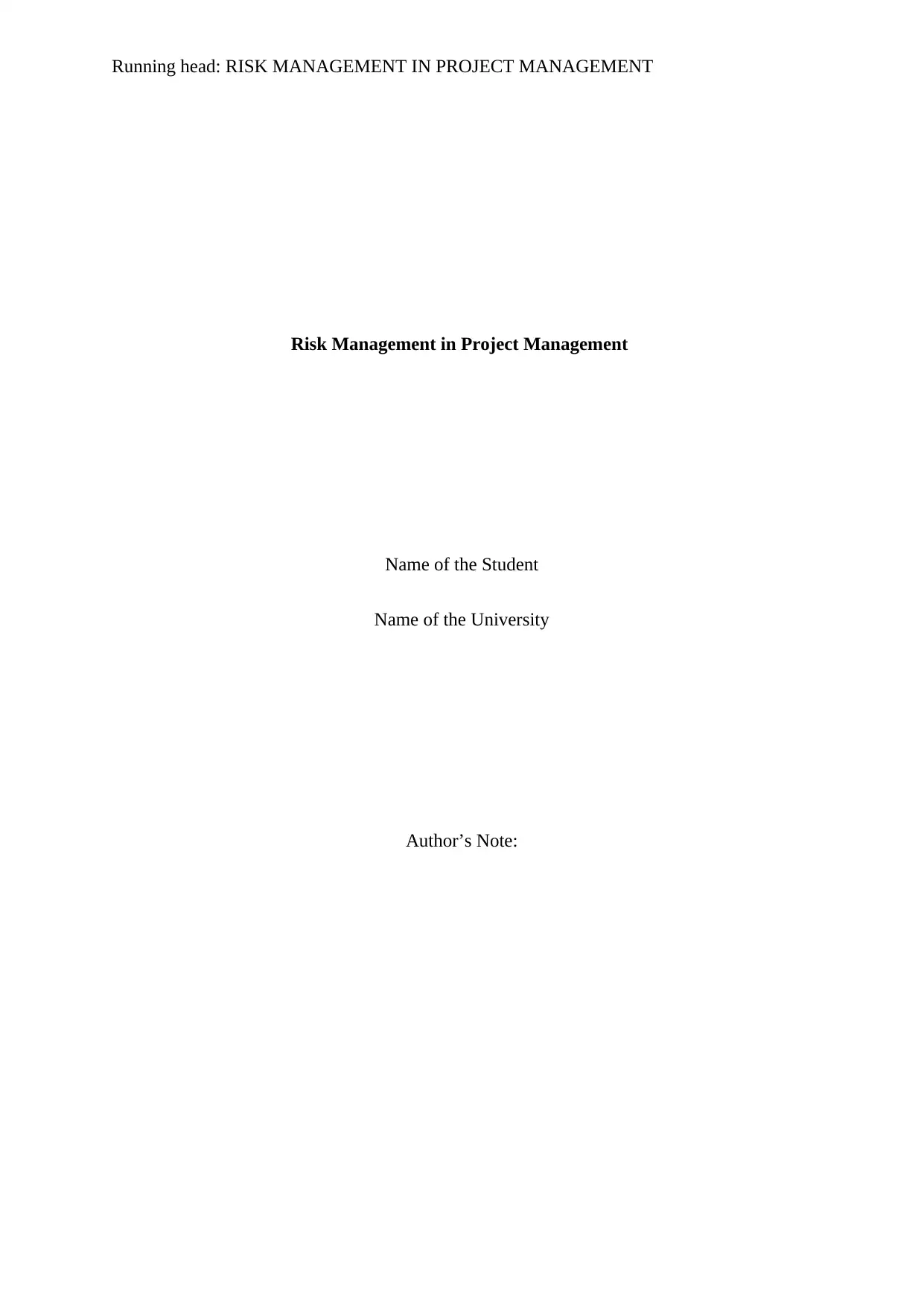
Running head: RISK MANAGEMENT IN PROJECT MANAGEMENT
Risk Management in Project Management
Name of the Student
Name of the University
Author’s Note:
Risk Management in Project Management
Name of the Student
Name of the University
Author’s Note:
Paraphrase This Document
Need a fresh take? Get an instant paraphrase of this document with our AI Paraphraser
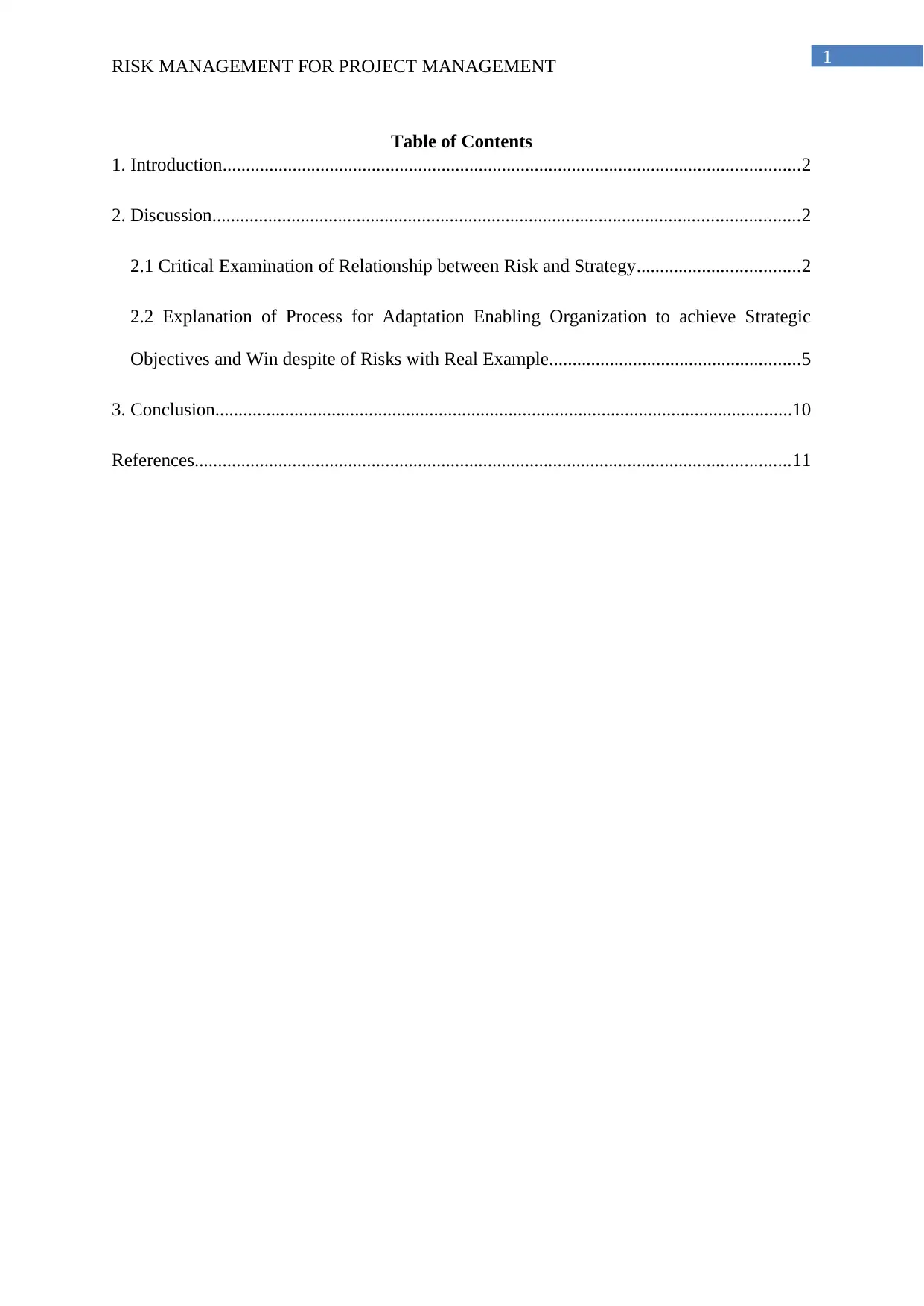
1
RISK MANAGEMENT FOR PROJECT MANAGEMENT
Table of Contents
1. Introduction............................................................................................................................2
2. Discussion..............................................................................................................................2
2.1 Critical Examination of Relationship between Risk and Strategy...................................2
2.2 Explanation of Process for Adaptation Enabling Organization to achieve Strategic
Objectives and Win despite of Risks with Real Example......................................................5
3. Conclusion............................................................................................................................10
References................................................................................................................................11
RISK MANAGEMENT FOR PROJECT MANAGEMENT
Table of Contents
1. Introduction............................................................................................................................2
2. Discussion..............................................................................................................................2
2.1 Critical Examination of Relationship between Risk and Strategy...................................2
2.2 Explanation of Process for Adaptation Enabling Organization to achieve Strategic
Objectives and Win despite of Risks with Real Example......................................................5
3. Conclusion............................................................................................................................10
References................................................................................................................................11
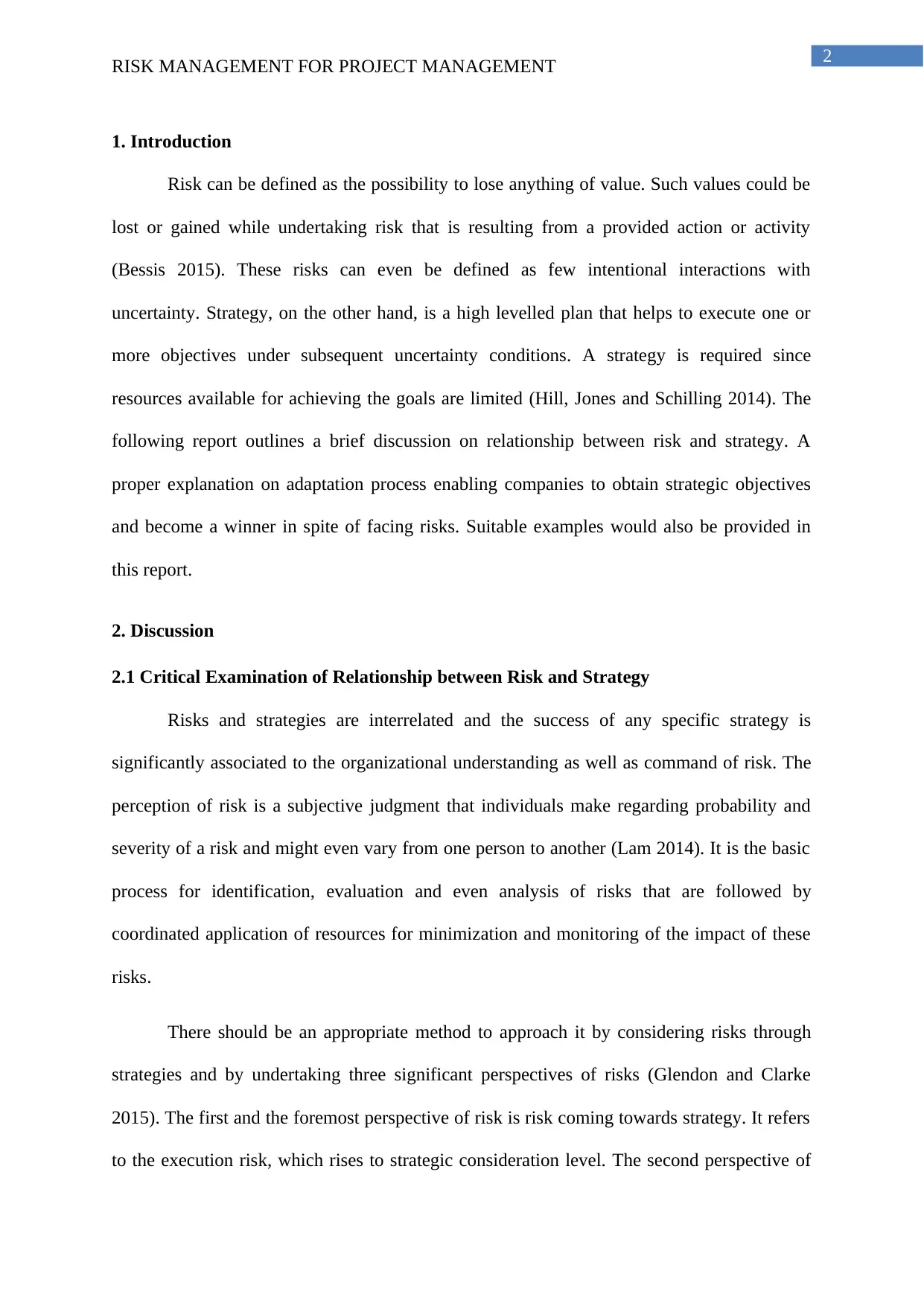
2
RISK MANAGEMENT FOR PROJECT MANAGEMENT
1. Introduction
Risk can be defined as the possibility to lose anything of value. Such values could be
lost or gained while undertaking risk that is resulting from a provided action or activity
(Bessis 2015). These risks can even be defined as few intentional interactions with
uncertainty. Strategy, on the other hand, is a high levelled plan that helps to execute one or
more objectives under subsequent uncertainty conditions. A strategy is required since
resources available for achieving the goals are limited (Hill, Jones and Schilling 2014). The
following report outlines a brief discussion on relationship between risk and strategy. A
proper explanation on adaptation process enabling companies to obtain strategic objectives
and become a winner in spite of facing risks. Suitable examples would also be provided in
this report.
2. Discussion
2.1 Critical Examination of Relationship between Risk and Strategy
Risks and strategies are interrelated and the success of any specific strategy is
significantly associated to the organizational understanding as well as command of risk. The
perception of risk is a subjective judgment that individuals make regarding probability and
severity of a risk and might even vary from one person to another (Lam 2014). It is the basic
process for identification, evaluation and even analysis of risks that are followed by
coordinated application of resources for minimization and monitoring of the impact of these
risks.
There should be an appropriate method to approach it by considering risks through
strategies and by undertaking three significant perspectives of risks (Glendon and Clarke
2015). The first and the foremost perspective of risk is risk coming towards strategy. It refers
to the execution risk, which rises to strategic consideration level. The second perspective of
RISK MANAGEMENT FOR PROJECT MANAGEMENT
1. Introduction
Risk can be defined as the possibility to lose anything of value. Such values could be
lost or gained while undertaking risk that is resulting from a provided action or activity
(Bessis 2015). These risks can even be defined as few intentional interactions with
uncertainty. Strategy, on the other hand, is a high levelled plan that helps to execute one or
more objectives under subsequent uncertainty conditions. A strategy is required since
resources available for achieving the goals are limited (Hill, Jones and Schilling 2014). The
following report outlines a brief discussion on relationship between risk and strategy. A
proper explanation on adaptation process enabling companies to obtain strategic objectives
and become a winner in spite of facing risks. Suitable examples would also be provided in
this report.
2. Discussion
2.1 Critical Examination of Relationship between Risk and Strategy
Risks and strategies are interrelated and the success of any specific strategy is
significantly associated to the organizational understanding as well as command of risk. The
perception of risk is a subjective judgment that individuals make regarding probability and
severity of a risk and might even vary from one person to another (Lam 2014). It is the basic
process for identification, evaluation and even analysis of risks that are followed by
coordinated application of resources for minimization and monitoring of the impact of these
risks.
There should be an appropriate method to approach it by considering risks through
strategies and by undertaking three significant perspectives of risks (Glendon and Clarke
2015). The first and the foremost perspective of risk is risk coming towards strategy. It refers
to the execution risk, which rises to strategic consideration level. The second perspective of
⊘ This is a preview!⊘
Do you want full access?
Subscribe today to unlock all pages.

Trusted by 1+ million students worldwide

3
RISK MANAGEMENT FOR PROJECT MANAGEMENT
risk is risk coming from strategy. This particular perspective refers to risk profile of strategy
and each and every alternative. The third or final perspective of risk is risk of the strategy
itself. It refers to the risk of the strategy and not moving entire organization for understanding
the context. All of these three perspectives are utilized in any organization by strategic
functions (Cardona 2013). An organizational strategic plan is responsible for setting
framework for its business planning cycle.
The main focus of business planning is given on processes, which assist the company
to obtain its intended result in long term and short term (Pritchard and PMP 2014). Hence,
there is a close relationship within organizational strategic objectives or goals and
management of every risk for which it is being exposed. It is quite important that any
company has the ability to ensure a distinctive continuity of processes irrespective of the
probability of risks affecting the business. An effective business strategy has the capability to
recognize future opportunities and significant weaknesses of the company (Chance and
Brooks 2015). A plan for managing risks can lead to proper development of few strategies of
risk reduction. Therefore, it is vital to determine if strategies for risk minimization have
capability to handle risk properly. Several risk controls might be difficult for the company to
exploit opportunity.
The business strategy would establish at the inception of cohesive processes and
policies for ensuring that probable risks are being managed and that the business objectives
are fulfilled effectively and efficiently, after consideration of organizational governance
framework requirements (Eden and Ackermann 2013). The risk management is extremely
effective when corporate culture eventually encourages every organizational member to
ensure a balanced role. These organizational members must be aware of the risks and should
bring subsequent risk issues to managerial attention. Moreover, they should be both
innovative and entrepreneurial when risk provides an opportunity towards rewards.
RISK MANAGEMENT FOR PROJECT MANAGEMENT
risk is risk coming from strategy. This particular perspective refers to risk profile of strategy
and each and every alternative. The third or final perspective of risk is risk of the strategy
itself. It refers to the risk of the strategy and not moving entire organization for understanding
the context. All of these three perspectives are utilized in any organization by strategic
functions (Cardona 2013). An organizational strategic plan is responsible for setting
framework for its business planning cycle.
The main focus of business planning is given on processes, which assist the company
to obtain its intended result in long term and short term (Pritchard and PMP 2014). Hence,
there is a close relationship within organizational strategic objectives or goals and
management of every risk for which it is being exposed. It is quite important that any
company has the ability to ensure a distinctive continuity of processes irrespective of the
probability of risks affecting the business. An effective business strategy has the capability to
recognize future opportunities and significant weaknesses of the company (Chance and
Brooks 2015). A plan for managing risks can lead to proper development of few strategies of
risk reduction. Therefore, it is vital to determine if strategies for risk minimization have
capability to handle risk properly. Several risk controls might be difficult for the company to
exploit opportunity.
The business strategy would establish at the inception of cohesive processes and
policies for ensuring that probable risks are being managed and that the business objectives
are fulfilled effectively and efficiently, after consideration of organizational governance
framework requirements (Eden and Ackermann 2013). The risk management is extremely
effective when corporate culture eventually encourages every organizational member to
ensure a balanced role. These organizational members must be aware of the risks and should
bring subsequent risk issues to managerial attention. Moreover, they should be both
innovative and entrepreneurial when risk provides an opportunity towards rewards.
Paraphrase This Document
Need a fresh take? Get an instant paraphrase of this document with our AI Paraphraser
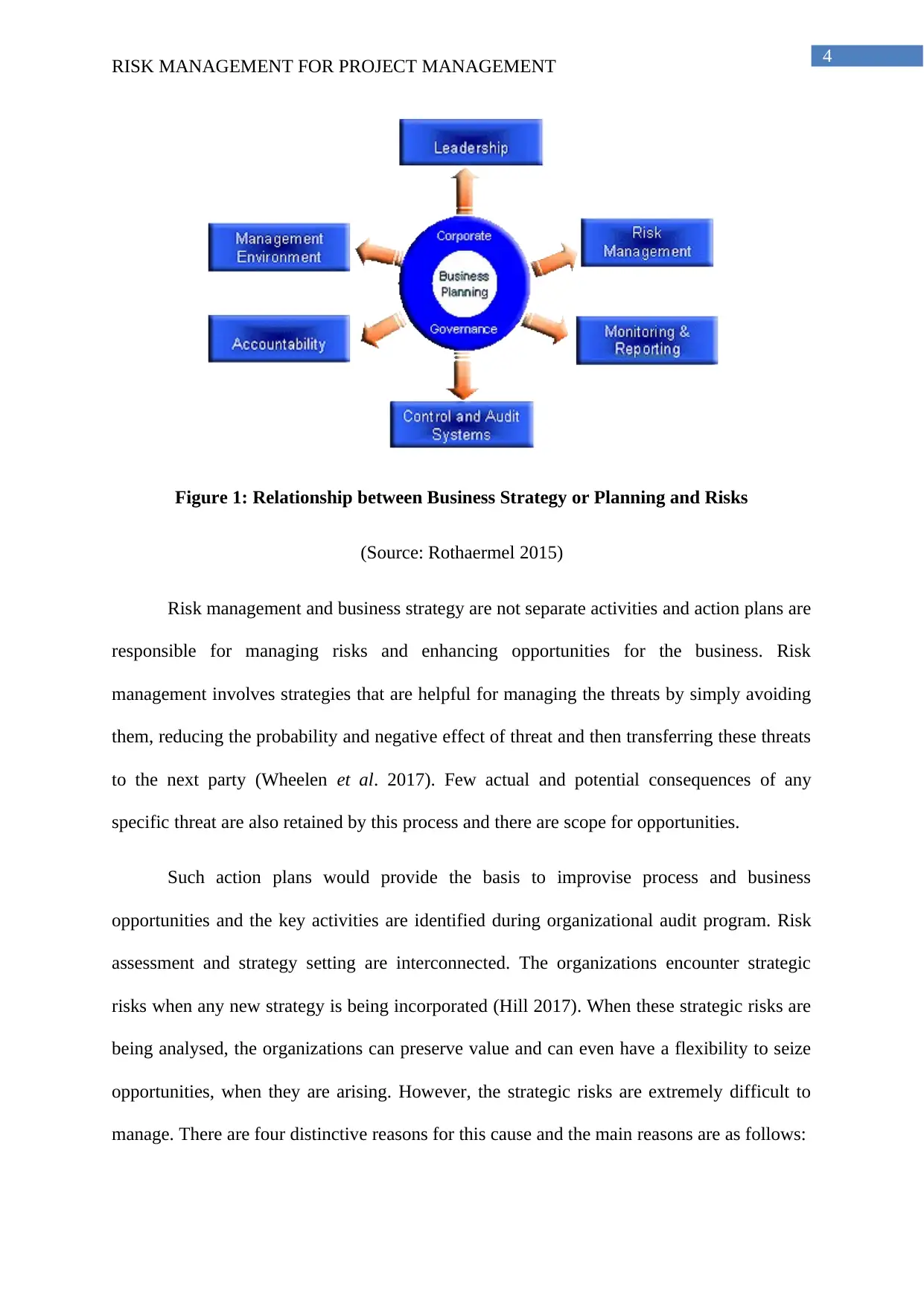
4
RISK MANAGEMENT FOR PROJECT MANAGEMENT
Figure 1: Relationship between Business Strategy or Planning and Risks
(Source: Rothaermel 2015)
Risk management and business strategy are not separate activities and action plans are
responsible for managing risks and enhancing opportunities for the business. Risk
management involves strategies that are helpful for managing the threats by simply avoiding
them, reducing the probability and negative effect of threat and then transferring these threats
to the next party (Wheelen et al. 2017). Few actual and potential consequences of any
specific threat are also retained by this process and there are scope for opportunities.
Such action plans would provide the basis to improvise process and business
opportunities and the key activities are identified during organizational audit program. Risk
assessment and strategy setting are interconnected. The organizations encounter strategic
risks when any new strategy is being incorporated (Hill 2017). When these strategic risks are
being analysed, the organizations can preserve value and can even have a flexibility to seize
opportunities, when they are arising. However, the strategic risks are extremely difficult to
manage. There are four distinctive reasons for this cause and the main reasons are as follows:
RISK MANAGEMENT FOR PROJECT MANAGEMENT
Figure 1: Relationship between Business Strategy or Planning and Risks
(Source: Rothaermel 2015)
Risk management and business strategy are not separate activities and action plans are
responsible for managing risks and enhancing opportunities for the business. Risk
management involves strategies that are helpful for managing the threats by simply avoiding
them, reducing the probability and negative effect of threat and then transferring these threats
to the next party (Wheelen et al. 2017). Few actual and potential consequences of any
specific threat are also retained by this process and there are scope for opportunities.
Such action plans would provide the basis to improvise process and business
opportunities and the key activities are identified during organizational audit program. Risk
assessment and strategy setting are interconnected. The organizations encounter strategic
risks when any new strategy is being incorporated (Hill 2017). When these strategic risks are
being analysed, the organizations can preserve value and can even have a flexibility to seize
opportunities, when they are arising. However, the strategic risks are extremely difficult to
manage. There are four distinctive reasons for this cause and the main reasons are as follows:

5
RISK MANAGEMENT FOR PROJECT MANAGEMENT
i) The strategic risks are extremely difficult to evaluate as well as measure.
ii) The next reason is that the strategic risks can manifest themselves for long time in
comparison to managers getting accustomed for evaluation (Aven 2016).
iii) The assessment of strategic risk even needs the organizational managers to think
about the negative side of respective business strategies within the company.
iv) Another important reason of difficulty in managing strategic risk is that such risks
often could arise of uncertainty and could even be unprecedented. The organizational leaders
have to use extra effort for both identification and monitoring of potential strategic risks.
A main focus is given to regular operational activity and internal checks for balancing
a stable relation between risk and strategy, which only appreciates creation of value in
business (Hill, Jones and Schilling 2014).
2.2 Explanation of Process for Adaptation Enabling Organization to achieve Strategic
Objectives and Win despite of Risks with Real Example
Adaptation is one of the most significant features, which is required in an organization
as it is helpful in making the business processes much improvised. Communication
adaptation is one of these examples that change the communication for any particular
employee due to changes in strategies. An organization should have the ability to get adapted
in certain negative situations so that risks are being identified and mitigated effectively
(Bolton, Chen and Wang 2013). Adaptability enables employees to manage any type of
difficult situation, which might be handed to them and provide an effective solution.
Technology is evolving eventually for making the entire process to be extremely innovative
and creative and even to stay open to the constant alterations in technology. This adaptability
in an organization is when any organizational member could be flexible and have the
capability to get adapted to changing working conditions.
RISK MANAGEMENT FOR PROJECT MANAGEMENT
i) The strategic risks are extremely difficult to evaluate as well as measure.
ii) The next reason is that the strategic risks can manifest themselves for long time in
comparison to managers getting accustomed for evaluation (Aven 2016).
iii) The assessment of strategic risk even needs the organizational managers to think
about the negative side of respective business strategies within the company.
iv) Another important reason of difficulty in managing strategic risk is that such risks
often could arise of uncertainty and could even be unprecedented. The organizational leaders
have to use extra effort for both identification and monitoring of potential strategic risks.
A main focus is given to regular operational activity and internal checks for balancing
a stable relation between risk and strategy, which only appreciates creation of value in
business (Hill, Jones and Schilling 2014).
2.2 Explanation of Process for Adaptation Enabling Organization to achieve Strategic
Objectives and Win despite of Risks with Real Example
Adaptation is one of the most significant features, which is required in an organization
as it is helpful in making the business processes much improvised. Communication
adaptation is one of these examples that change the communication for any particular
employee due to changes in strategies. An organization should have the ability to get adapted
in certain negative situations so that risks are being identified and mitigated effectively
(Bolton, Chen and Wang 2013). Adaptability enables employees to manage any type of
difficult situation, which might be handed to them and provide an effective solution.
Technology is evolving eventually for making the entire process to be extremely innovative
and creative and even to stay open to the constant alterations in technology. This adaptability
in an organization is when any organizational member could be flexible and have the
capability to get adapted to changing working conditions.
⊘ This is a preview!⊘
Do you want full access?
Subscribe today to unlock all pages.

Trusted by 1+ million students worldwide
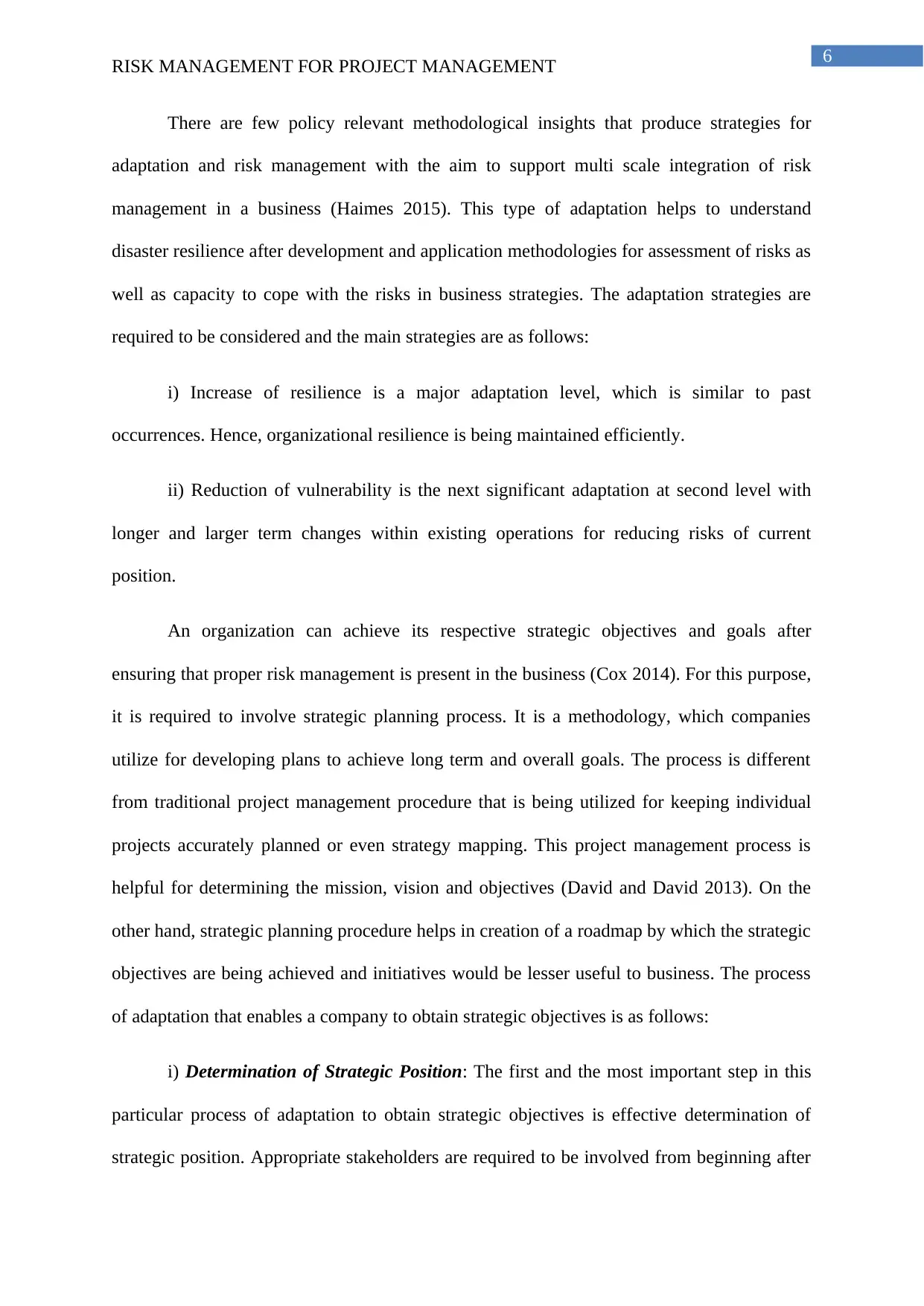
6
RISK MANAGEMENT FOR PROJECT MANAGEMENT
There are few policy relevant methodological insights that produce strategies for
adaptation and risk management with the aim to support multi scale integration of risk
management in a business (Haimes 2015). This type of adaptation helps to understand
disaster resilience after development and application methodologies for assessment of risks as
well as capacity to cope with the risks in business strategies. The adaptation strategies are
required to be considered and the main strategies are as follows:
i) Increase of resilience is a major adaptation level, which is similar to past
occurrences. Hence, organizational resilience is being maintained efficiently.
ii) Reduction of vulnerability is the next significant adaptation at second level with
longer and larger term changes within existing operations for reducing risks of current
position.
An organization can achieve its respective strategic objectives and goals after
ensuring that proper risk management is present in the business (Cox 2014). For this purpose,
it is required to involve strategic planning process. It is a methodology, which companies
utilize for developing plans to achieve long term and overall goals. The process is different
from traditional project management procedure that is being utilized for keeping individual
projects accurately planned or even strategy mapping. This project management process is
helpful for determining the mission, vision and objectives (David and David 2013). On the
other hand, strategic planning procedure helps in creation of a roadmap by which the strategic
objectives are being achieved and initiatives would be lesser useful to business. The process
of adaptation that enables a company to obtain strategic objectives is as follows:
i) Determination of Strategic Position: The first and the most important step in this
particular process of adaptation to obtain strategic objectives is effective determination of
strategic position. Appropriate stakeholders are required to be involved from beginning after
RISK MANAGEMENT FOR PROJECT MANAGEMENT
There are few policy relevant methodological insights that produce strategies for
adaptation and risk management with the aim to support multi scale integration of risk
management in a business (Haimes 2015). This type of adaptation helps to understand
disaster resilience after development and application methodologies for assessment of risks as
well as capacity to cope with the risks in business strategies. The adaptation strategies are
required to be considered and the main strategies are as follows:
i) Increase of resilience is a major adaptation level, which is similar to past
occurrences. Hence, organizational resilience is being maintained efficiently.
ii) Reduction of vulnerability is the next significant adaptation at second level with
longer and larger term changes within existing operations for reducing risks of current
position.
An organization can achieve its respective strategic objectives and goals after
ensuring that proper risk management is present in the business (Cox 2014). For this purpose,
it is required to involve strategic planning process. It is a methodology, which companies
utilize for developing plans to achieve long term and overall goals. The process is different
from traditional project management procedure that is being utilized for keeping individual
projects accurately planned or even strategy mapping. This project management process is
helpful for determining the mission, vision and objectives (David and David 2013). On the
other hand, strategic planning procedure helps in creation of a roadmap by which the strategic
objectives are being achieved and initiatives would be lesser useful to business. The process
of adaptation that enables a company to obtain strategic objectives is as follows:
i) Determination of Strategic Position: The first and the most important step in this
particular process of adaptation to obtain strategic objectives is effective determination of
strategic position. Appropriate stakeholders are required to be involved from beginning after
Paraphrase This Document
Need a fresh take? Get an instant paraphrase of this document with our AI Paraphraser
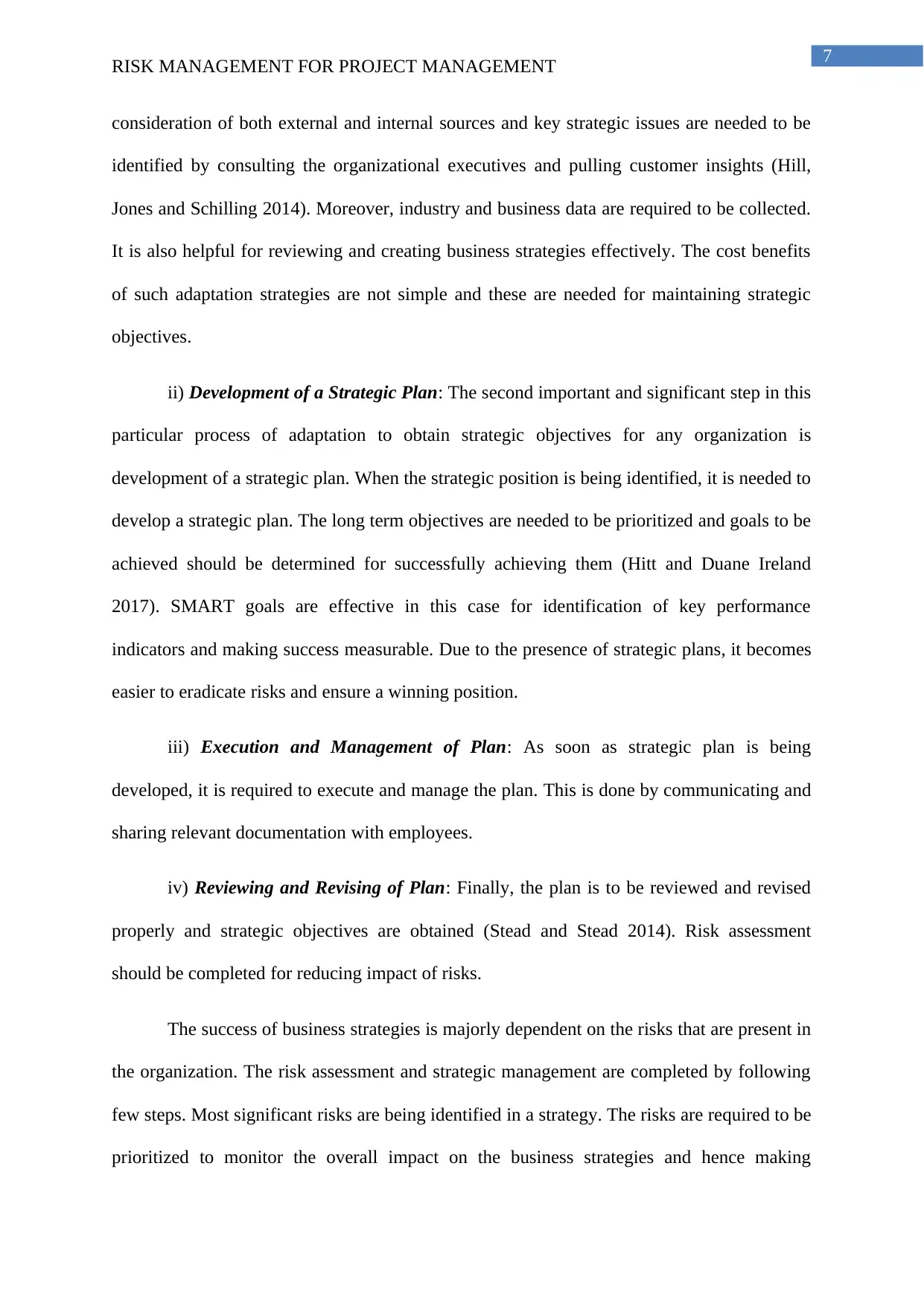
7
RISK MANAGEMENT FOR PROJECT MANAGEMENT
consideration of both external and internal sources and key strategic issues are needed to be
identified by consulting the organizational executives and pulling customer insights (Hill,
Jones and Schilling 2014). Moreover, industry and business data are required to be collected.
It is also helpful for reviewing and creating business strategies effectively. The cost benefits
of such adaptation strategies are not simple and these are needed for maintaining strategic
objectives.
ii) Development of a Strategic Plan: The second important and significant step in this
particular process of adaptation to obtain strategic objectives for any organization is
development of a strategic plan. When the strategic position is being identified, it is needed to
develop a strategic plan. The long term objectives are needed to be prioritized and goals to be
achieved should be determined for successfully achieving them (Hitt and Duane Ireland
2017). SMART goals are effective in this case for identification of key performance
indicators and making success measurable. Due to the presence of strategic plans, it becomes
easier to eradicate risks and ensure a winning position.
iii) Execution and Management of Plan: As soon as strategic plan is being
developed, it is required to execute and manage the plan. This is done by communicating and
sharing relevant documentation with employees.
iv) Reviewing and Revising of Plan: Finally, the plan is to be reviewed and revised
properly and strategic objectives are obtained (Stead and Stead 2014). Risk assessment
should be completed for reducing impact of risks.
The success of business strategies is majorly dependent on the risks that are present in
the organization. The risk assessment and strategic management are completed by following
few steps. Most significant risks are being identified in a strategy. The risks are required to be
prioritized to monitor the overall impact on the business strategies and hence making
RISK MANAGEMENT FOR PROJECT MANAGEMENT
consideration of both external and internal sources and key strategic issues are needed to be
identified by consulting the organizational executives and pulling customer insights (Hill,
Jones and Schilling 2014). Moreover, industry and business data are required to be collected.
It is also helpful for reviewing and creating business strategies effectively. The cost benefits
of such adaptation strategies are not simple and these are needed for maintaining strategic
objectives.
ii) Development of a Strategic Plan: The second important and significant step in this
particular process of adaptation to obtain strategic objectives for any organization is
development of a strategic plan. When the strategic position is being identified, it is needed to
develop a strategic plan. The long term objectives are needed to be prioritized and goals to be
achieved should be determined for successfully achieving them (Hitt and Duane Ireland
2017). SMART goals are effective in this case for identification of key performance
indicators and making success measurable. Due to the presence of strategic plans, it becomes
easier to eradicate risks and ensure a winning position.
iii) Execution and Management of Plan: As soon as strategic plan is being
developed, it is required to execute and manage the plan. This is done by communicating and
sharing relevant documentation with employees.
iv) Reviewing and Revising of Plan: Finally, the plan is to be reviewed and revised
properly and strategic objectives are obtained (Stead and Stead 2014). Risk assessment
should be completed for reducing impact of risks.
The success of business strategies is majorly dependent on the risks that are present in
the organization. The risk assessment and strategic management are completed by following
few steps. Most significant risks are being identified in a strategy. The risks are required to be
prioritized to monitor the overall impact on the business strategies and hence making
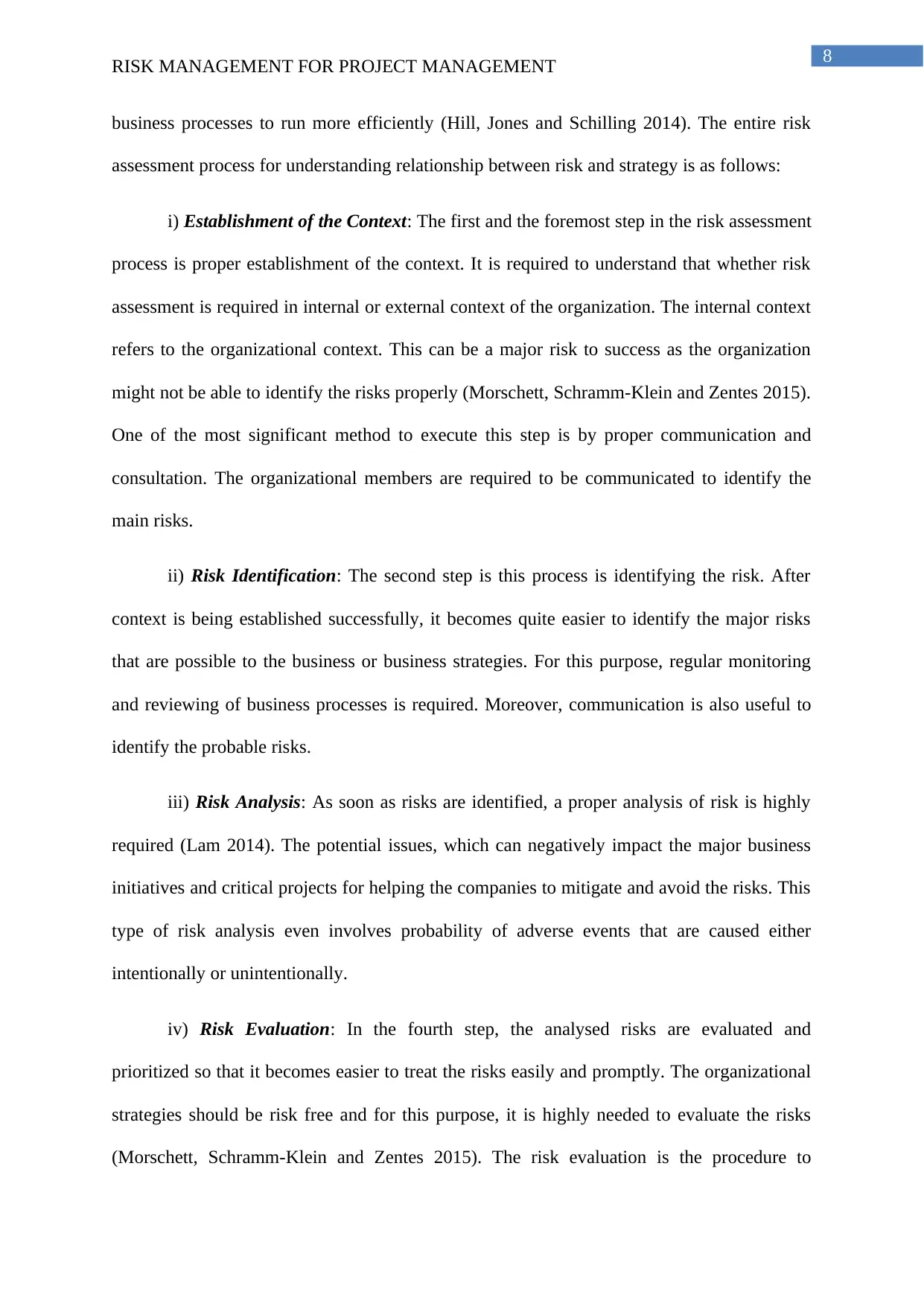
8
RISK MANAGEMENT FOR PROJECT MANAGEMENT
business processes to run more efficiently (Hill, Jones and Schilling 2014). The entire risk
assessment process for understanding relationship between risk and strategy is as follows:
i) Establishment of the Context: The first and the foremost step in the risk assessment
process is proper establishment of the context. It is required to understand that whether risk
assessment is required in internal or external context of the organization. The internal context
refers to the organizational context. This can be a major risk to success as the organization
might not be able to identify the risks properly (Morschett, Schramm-Klein and Zentes 2015).
One of the most significant method to execute this step is by proper communication and
consultation. The organizational members are required to be communicated to identify the
main risks.
ii) Risk Identification: The second step is this process is identifying the risk. After
context is being established successfully, it becomes quite easier to identify the major risks
that are possible to the business or business strategies. For this purpose, regular monitoring
and reviewing of business processes is required. Moreover, communication is also useful to
identify the probable risks.
iii) Risk Analysis: As soon as risks are identified, a proper analysis of risk is highly
required (Lam 2014). The potential issues, which can negatively impact the major business
initiatives and critical projects for helping the companies to mitigate and avoid the risks. This
type of risk analysis even involves probability of adverse events that are caused either
intentionally or unintentionally.
iv) Risk Evaluation: In the fourth step, the analysed risks are evaluated and
prioritized so that it becomes easier to treat the risks easily and promptly. The organizational
strategies should be risk free and for this purpose, it is highly needed to evaluate the risks
(Morschett, Schramm-Klein and Zentes 2015). The risk evaluation is the procedure to
RISK MANAGEMENT FOR PROJECT MANAGEMENT
business processes to run more efficiently (Hill, Jones and Schilling 2014). The entire risk
assessment process for understanding relationship between risk and strategy is as follows:
i) Establishment of the Context: The first and the foremost step in the risk assessment
process is proper establishment of the context. It is required to understand that whether risk
assessment is required in internal or external context of the organization. The internal context
refers to the organizational context. This can be a major risk to success as the organization
might not be able to identify the risks properly (Morschett, Schramm-Klein and Zentes 2015).
One of the most significant method to execute this step is by proper communication and
consultation. The organizational members are required to be communicated to identify the
main risks.
ii) Risk Identification: The second step is this process is identifying the risk. After
context is being established successfully, it becomes quite easier to identify the major risks
that are possible to the business or business strategies. For this purpose, regular monitoring
and reviewing of business processes is required. Moreover, communication is also useful to
identify the probable risks.
iii) Risk Analysis: As soon as risks are identified, a proper analysis of risk is highly
required (Lam 2014). The potential issues, which can negatively impact the major business
initiatives and critical projects for helping the companies to mitigate and avoid the risks. This
type of risk analysis even involves probability of adverse events that are caused either
intentionally or unintentionally.
iv) Risk Evaluation: In the fourth step, the analysed risks are evaluated and
prioritized so that it becomes easier to treat the risks easily and promptly. The organizational
strategies should be risk free and for this purpose, it is highly needed to evaluate the risks
(Morschett, Schramm-Klein and Zentes 2015). The risk evaluation is the procedure to
⊘ This is a preview!⊘
Do you want full access?
Subscribe today to unlock all pages.

Trusted by 1+ million students worldwide
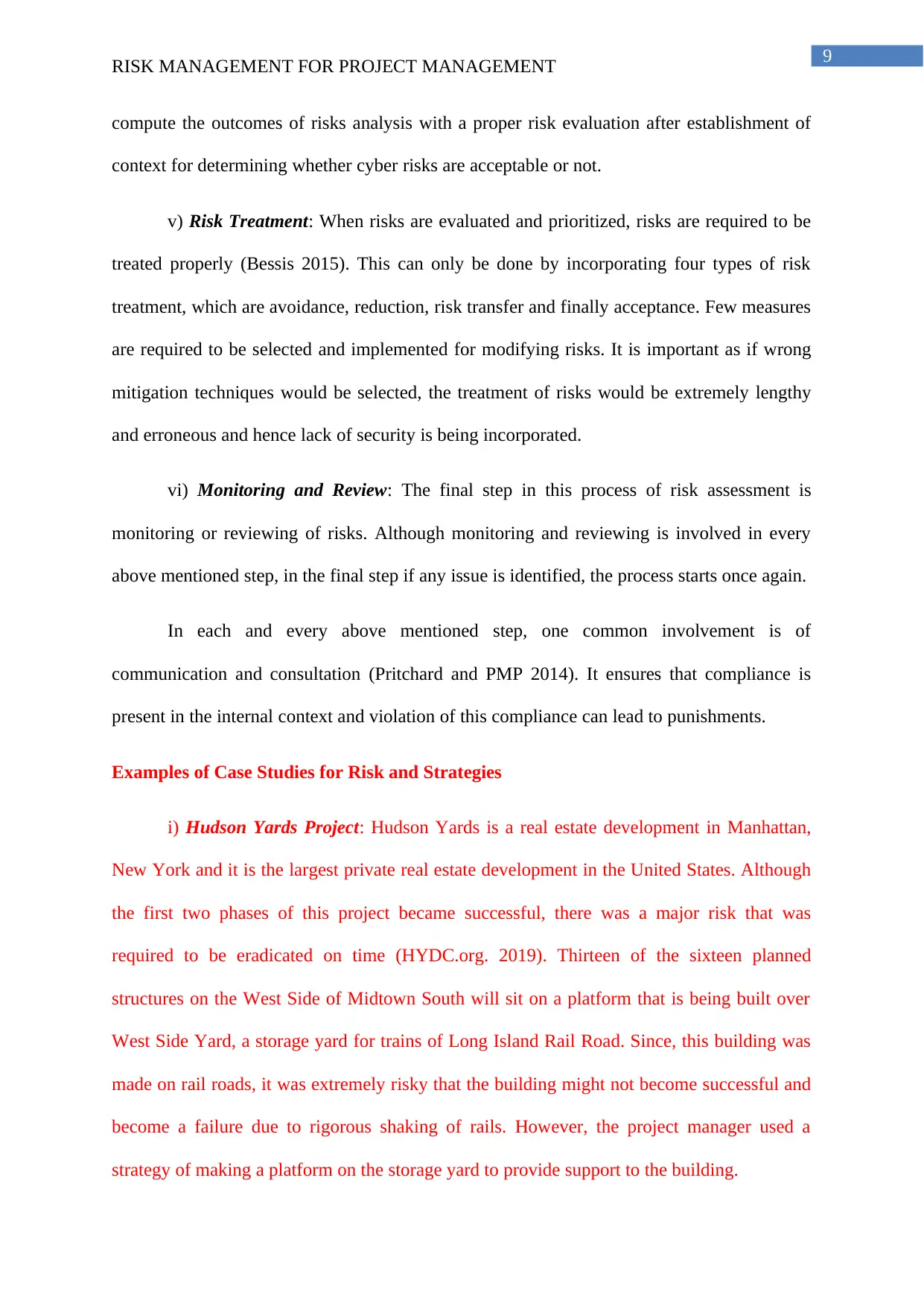
9
RISK MANAGEMENT FOR PROJECT MANAGEMENT
compute the outcomes of risks analysis with a proper risk evaluation after establishment of
context for determining whether cyber risks are acceptable or not.
v) Risk Treatment: When risks are evaluated and prioritized, risks are required to be
treated properly (Bessis 2015). This can only be done by incorporating four types of risk
treatment, which are avoidance, reduction, risk transfer and finally acceptance. Few measures
are required to be selected and implemented for modifying risks. It is important as if wrong
mitigation techniques would be selected, the treatment of risks would be extremely lengthy
and erroneous and hence lack of security is being incorporated.
vi) Monitoring and Review: The final step in this process of risk assessment is
monitoring or reviewing of risks. Although monitoring and reviewing is involved in every
above mentioned step, in the final step if any issue is identified, the process starts once again.
In each and every above mentioned step, one common involvement is of
communication and consultation (Pritchard and PMP 2014). It ensures that compliance is
present in the internal context and violation of this compliance can lead to punishments.
Examples of Case Studies for Risk and Strategies
i) Hudson Yards Project: Hudson Yards is a real estate development in Manhattan,
New York and it is the largest private real estate development in the United States. Although
the first two phases of this project became successful, there was a major risk that was
required to be eradicated on time (HYDC.org. 2019). Thirteen of the sixteen planned
structures on the West Side of Midtown South will sit on a platform that is being built over
West Side Yard, a storage yard for trains of Long Island Rail Road. Since, this building was
made on rail roads, it was extremely risky that the building might not become successful and
become a failure due to rigorous shaking of rails. However, the project manager used a
strategy of making a platform on the storage yard to provide support to the building.
RISK MANAGEMENT FOR PROJECT MANAGEMENT
compute the outcomes of risks analysis with a proper risk evaluation after establishment of
context for determining whether cyber risks are acceptable or not.
v) Risk Treatment: When risks are evaluated and prioritized, risks are required to be
treated properly (Bessis 2015). This can only be done by incorporating four types of risk
treatment, which are avoidance, reduction, risk transfer and finally acceptance. Few measures
are required to be selected and implemented for modifying risks. It is important as if wrong
mitigation techniques would be selected, the treatment of risks would be extremely lengthy
and erroneous and hence lack of security is being incorporated.
vi) Monitoring and Review: The final step in this process of risk assessment is
monitoring or reviewing of risks. Although monitoring and reviewing is involved in every
above mentioned step, in the final step if any issue is identified, the process starts once again.
In each and every above mentioned step, one common involvement is of
communication and consultation (Pritchard and PMP 2014). It ensures that compliance is
present in the internal context and violation of this compliance can lead to punishments.
Examples of Case Studies for Risk and Strategies
i) Hudson Yards Project: Hudson Yards is a real estate development in Manhattan,
New York and it is the largest private real estate development in the United States. Although
the first two phases of this project became successful, there was a major risk that was
required to be eradicated on time (HYDC.org. 2019). Thirteen of the sixteen planned
structures on the West Side of Midtown South will sit on a platform that is being built over
West Side Yard, a storage yard for trains of Long Island Rail Road. Since, this building was
made on rail roads, it was extremely risky that the building might not become successful and
become a failure due to rigorous shaking of rails. However, the project manager used a
strategy of making a platform on the storage yard to provide support to the building.
Paraphrase This Document
Need a fresh take? Get an instant paraphrase of this document with our AI Paraphraser

10
RISK MANAGEMENT FOR PROJECT MANAGEMENT
ii) Sydney Metro: This project is considered as one of the greatest metro rail networks
in Sydney, Australia. The main risk that was faced in this particular project was undertaking
climate change risk assessment. As Sydney metro is aligned with NSW’s commitment for
taking proper action on climate change, the major impacts of climate change risk over the life
of railway line were negative (Sydney Metro Sustainability Report 2017). The project lacked
future flexibility and inappropriate resilience. To eradicate this issue, project team made a
strategy of recognizing the importance of early identification of risks. They implemented few
measures of adaptation and thus was finally able to eradicate the issues effectively.
3. Conclusion
Therefore, from the above discussion, it can be concluded that risk management is
extremely important and significant for identifying any kind of risk or threat in the existing
project or work. The most strategy selected procedures always consider risk in their activities
and thus risks have potential effects on the ability to execute the respective strategy. The
above provided report has clearly outlined a detailed description on relationship between risk
and strategy and procedure of adaptation enabling companies to achieve the strategic
objectives in spite of the risks that are being faced in the process. Two examples of successful
projects are undertaken here for understanding risk and strategy. In the first project, Hudson
Yards faced major issues during planning as they were concerned about to shaking of
building due to underground railway system. However, the project manager implemented a
strategy of building platform before the building and hence risk was avoided. In the second
project, the climate change risks were extremely high and the project manager decided to
identify the risks using a risk assessment and hence was able to reduce the impact majorly.
RISK MANAGEMENT FOR PROJECT MANAGEMENT
ii) Sydney Metro: This project is considered as one of the greatest metro rail networks
in Sydney, Australia. The main risk that was faced in this particular project was undertaking
climate change risk assessment. As Sydney metro is aligned with NSW’s commitment for
taking proper action on climate change, the major impacts of climate change risk over the life
of railway line were negative (Sydney Metro Sustainability Report 2017). The project lacked
future flexibility and inappropriate resilience. To eradicate this issue, project team made a
strategy of recognizing the importance of early identification of risks. They implemented few
measures of adaptation and thus was finally able to eradicate the issues effectively.
3. Conclusion
Therefore, from the above discussion, it can be concluded that risk management is
extremely important and significant for identifying any kind of risk or threat in the existing
project or work. The most strategy selected procedures always consider risk in their activities
and thus risks have potential effects on the ability to execute the respective strategy. The
above provided report has clearly outlined a detailed description on relationship between risk
and strategy and procedure of adaptation enabling companies to achieve the strategic
objectives in spite of the risks that are being faced in the process. Two examples of successful
projects are undertaken here for understanding risk and strategy. In the first project, Hudson
Yards faced major issues during planning as they were concerned about to shaking of
building due to underground railway system. However, the project manager implemented a
strategy of building platform before the building and hence risk was avoided. In the second
project, the climate change risks were extremely high and the project manager decided to
identify the risks using a risk assessment and hence was able to reduce the impact majorly.
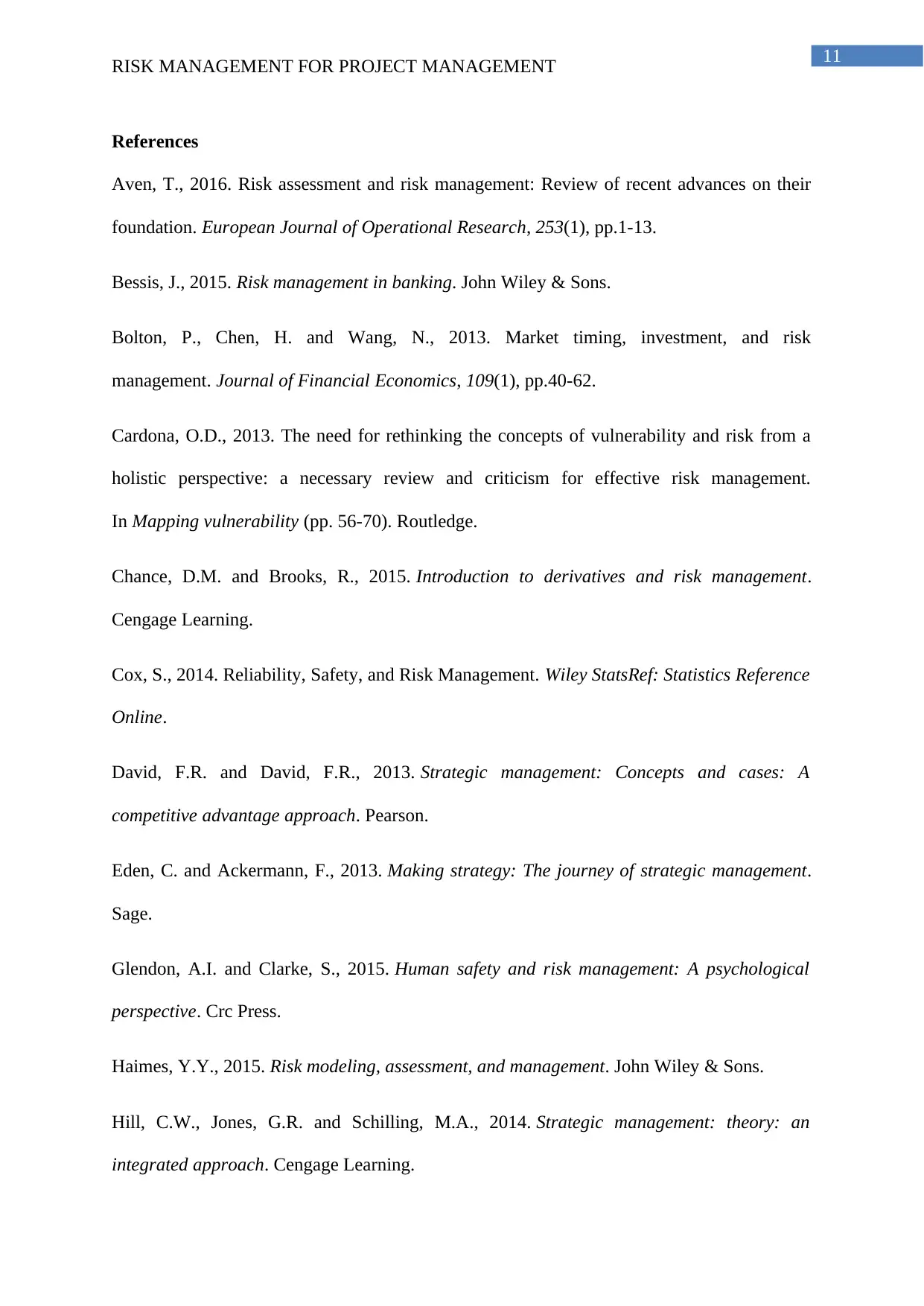
11
RISK MANAGEMENT FOR PROJECT MANAGEMENT
References
Aven, T., 2016. Risk assessment and risk management: Review of recent advances on their
foundation. European Journal of Operational Research, 253(1), pp.1-13.
Bessis, J., 2015. Risk management in banking. John Wiley & Sons.
Bolton, P., Chen, H. and Wang, N., 2013. Market timing, investment, and risk
management. Journal of Financial Economics, 109(1), pp.40-62.
Cardona, O.D., 2013. The need for rethinking the concepts of vulnerability and risk from a
holistic perspective: a necessary review and criticism for effective risk management.
In Mapping vulnerability (pp. 56-70). Routledge.
Chance, D.M. and Brooks, R., 2015. Introduction to derivatives and risk management.
Cengage Learning.
Cox, S., 2014. Reliability, Safety, and Risk Management. Wiley StatsRef: Statistics Reference
Online.
David, F.R. and David, F.R., 2013. Strategic management: Concepts and cases: A
competitive advantage approach. Pearson.
Eden, C. and Ackermann, F., 2013. Making strategy: The journey of strategic management.
Sage.
Glendon, A.I. and Clarke, S., 2015. Human safety and risk management: A psychological
perspective. Crc Press.
Haimes, Y.Y., 2015. Risk modeling, assessment, and management. John Wiley & Sons.
Hill, C.W., Jones, G.R. and Schilling, M.A., 2014. Strategic management: theory: an
integrated approach. Cengage Learning.
RISK MANAGEMENT FOR PROJECT MANAGEMENT
References
Aven, T., 2016. Risk assessment and risk management: Review of recent advances on their
foundation. European Journal of Operational Research, 253(1), pp.1-13.
Bessis, J., 2015. Risk management in banking. John Wiley & Sons.
Bolton, P., Chen, H. and Wang, N., 2013. Market timing, investment, and risk
management. Journal of Financial Economics, 109(1), pp.40-62.
Cardona, O.D., 2013. The need for rethinking the concepts of vulnerability and risk from a
holistic perspective: a necessary review and criticism for effective risk management.
In Mapping vulnerability (pp. 56-70). Routledge.
Chance, D.M. and Brooks, R., 2015. Introduction to derivatives and risk management.
Cengage Learning.
Cox, S., 2014. Reliability, Safety, and Risk Management. Wiley StatsRef: Statistics Reference
Online.
David, F.R. and David, F.R., 2013. Strategic management: Concepts and cases: A
competitive advantage approach. Pearson.
Eden, C. and Ackermann, F., 2013. Making strategy: The journey of strategic management.
Sage.
Glendon, A.I. and Clarke, S., 2015. Human safety and risk management: A psychological
perspective. Crc Press.
Haimes, Y.Y., 2015. Risk modeling, assessment, and management. John Wiley & Sons.
Hill, C.W., Jones, G.R. and Schilling, M.A., 2014. Strategic management: theory: an
integrated approach. Cengage Learning.
⊘ This is a preview!⊘
Do you want full access?
Subscribe today to unlock all pages.

Trusted by 1+ million students worldwide
1 out of 13
Related Documents
Your All-in-One AI-Powered Toolkit for Academic Success.
+13062052269
info@desklib.com
Available 24*7 on WhatsApp / Email
![[object Object]](/_next/static/media/star-bottom.7253800d.svg)
Unlock your academic potential
Copyright © 2020–2025 A2Z Services. All Rights Reserved. Developed and managed by ZUCOL.





